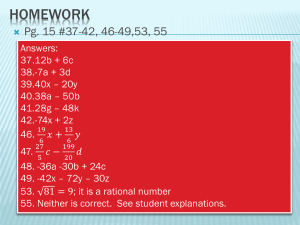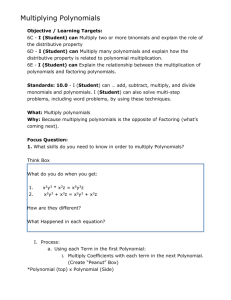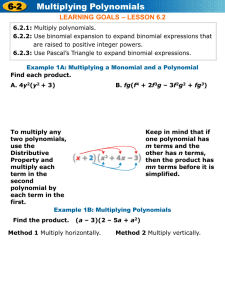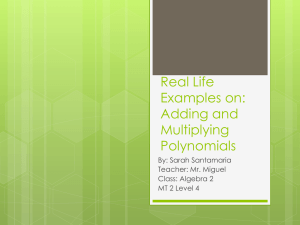Multiplying Polynomials LP (lesson 4)
advertisement
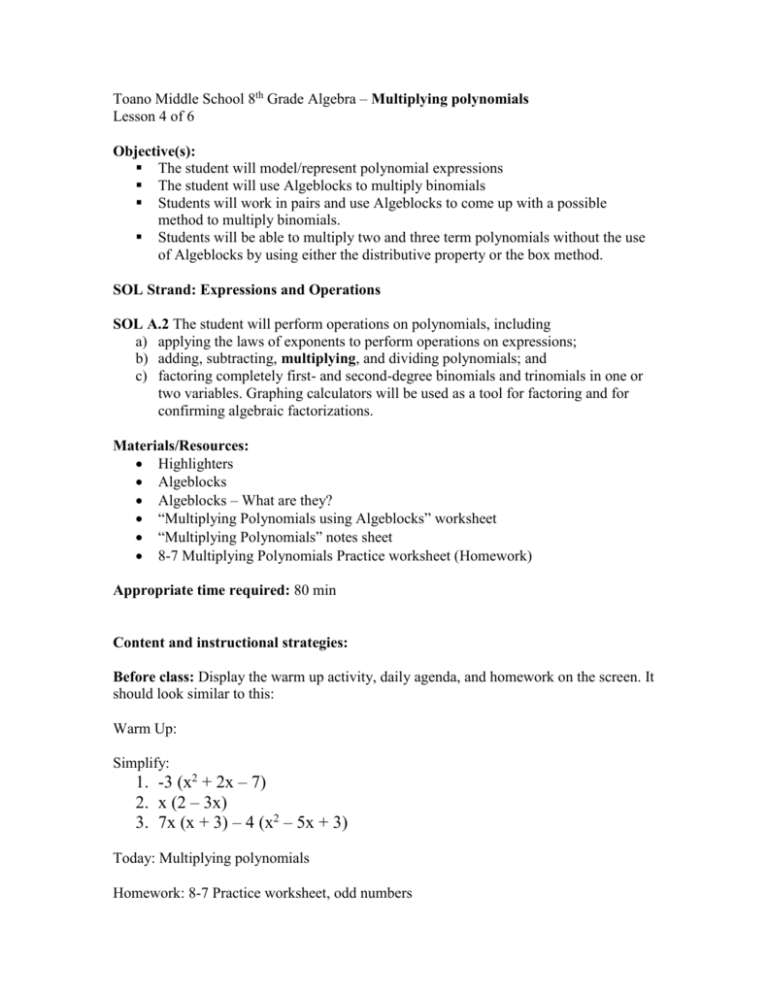
Toano Middle School 8th Grade Algebra – Multiplying polynomials Lesson 4 of 6 Objective(s): The student will model/represent polynomial expressions The student will use Algeblocks to multiply binomials Students will work in pairs and use Algeblocks to come up with a possible method to multiply binomials. Students will be able to multiply two and three term polynomials without the use of Algeblocks by using either the distributive property or the box method. SOL Strand: Expressions and Operations SOL A.2 The student will perform operations on polynomials, including a) applying the laws of exponents to perform operations on expressions; b) adding, subtracting, multiplying, and dividing polynomials; and c) factoring completely first- and second-degree binomials and trinomials in one or two variables. Graphing calculators will be used as a tool for factoring and for confirming algebraic factorizations. Materials/Resources: Highlighters Algeblocks Algeblocks – What are they? “Multiplying Polynomials using Algeblocks” worksheet “Multiplying Polynomials” notes sheet 8-7 Multiplying Polynomials Practice worksheet (Homework) Appropriate time required: 80 min Content and instructional strategies: Before class: Display the warm up activity, daily agenda, and homework on the screen. It should look similar to this: Warm Up: Simplify: 1. -3 (x2 + 2x – 7) 2. x (2 – 3x) 3. 7x (x + 3) – 4 (x2 – 5x + 3) Today: Multiplying polynomials Homework: 8-7 Practice worksheet, odd numbers Introduction 1. As students enter the room, they should begin to complete on the warm up activities. (5 min) 2. Review the problems with the students, asking them to recall and provide the steps in simplifying each problem. Possible questions include: “What is our first step? Do we need to combine like terms? Why or why not?” (5 min) New content – Algeblocks revisited 1. Allow students to arrange themselves into groups of two. Pass out a set of Algeblocks to each student and instruct them to re-familiarize themselves with the blocks (carefully) until everyone has their materials. [Provide another “Algeblocks-What are they?” worksheet or have them jot down what each piece represents if necessary]. Remind students about zero pairs and simplifying expressions. 2. Pass out a Multiplying Polynomials using Algeblocks worksheet to each student. Instruct students to take out the Algeblocks Quadrant Mat and the “X” or “+”. The center of the “+” should be at the center of the Mat (model this for the students if necessary). 3. Take a second to go over how to set up the Mat and divider. You may also wish to practice representing polynomials through models and naming them algebraically using the models. 4. Review with students the example of 3 x 2. Have them provide their answer. Model how to solve this problem using the area model with green “1” Algeblocks. Write the expected answer on the sheet, 6. 5. Now model 2(x + 3). Using prior knowledge and the previous lesson, students should be able to use the distributive property to get the answer of 2x + 6. Remind students that multiplication is commutative so you can either quantity into either arm of the divider, as long as the signs match. For this example, both quantities are positive so you should be working in the positive quadrant. Demonstrate how students would set up this problem using the algeblocks to multiply by having one factor on the side, the other on the bottom, and filling in the answer in the middle. 6. Ask students to model the expression x (x+3). Give students a few minutes to set up the problem. Once again, students will hopefully be able to solve the problem fairly quickly, but you want to stress to them that the point is to model the expression. Ask what the factors are and where they go. Walk around and provide assistance to struggling students. 7. Once students are comfortable with modeling these simpler polynomials (may need to create one or two more), present them with the next problem (x + 2) (x + 3). Give students a second to attempt to model the problem before answering, and then ask them similar questions to before, “What are the factors, where do they go, what do we multiply, etc.” Have students count up the number of each tile they have. There should be one X2 - Block, five X – Blocks, and six ones. Ask students what these blocks model: x2 + 5x + 6. 8. Present another problem to the students: (2x + 1) (x + 2), have them model and simplify it on their own. Walk around to assess student comprehension, assist as necessary, and then follow the same questioning procedure as before when going over the model as a class. 9. So far, we’ve only used the top right positive quadrant and the two positive gutters. Ask students what they think we would use the other gutters for and why the other quadrants are labeled the way they are. Try to get students to make the connection to the coordinate plan and the idea that the other positive quadrant is for when you multiple two negative numbers. 10. Have students multiply (x + 3) (x-2). Work through the example with them, explaining how to use the negative parts of the axes on the quadrant mat. Explain what happens to the blocks in the negative quadrant when there are similar blocks in the positive quadrant (zero pairs!). Ask what simplified polynomial does the model represent. 11. Model another polynomial with negatives if necessary (assess how your students did with the first polynomial) (2x – 1)(x + 3) 12. After students have modeled the problems above. Have the students work through the remaining problems on the worksheet (problem 7/8 – 10). While they do this, ask them to jot down any patterns they discover in order to create a possible rule for multiplying polynomials in general. Walk around while they are working with the blocks and ask them questions about their method: how it was developed, why they think it would work, etc. Also use this opportunity to help struggling students with the blocks. You can select students to share any “interesting” rule suggestions or rules that highlight key concepts that will be explored using the distributive or box methods [i.e. combining like terms (the O & I of F.O.I.L), importance of the first and last terms (F and L of F.O.I.L)] Don’t spend too long on this activity though, it is only to get them thinking! Multiplying Polynomials notes worksheet 1. Have students quickly and carefully return all the pieces to their respective places and clean up their areas. Pass out a notes worksheet to each student (5 min). 2. Highlight the fact that there are three ways to multiply polynomials (Distributive property, Box method, and FOIL) 3. Work through the first example under Method 1: Distributive property with the class. Be sure to highlight the signs and remind students to pay careful attention to negatives when distributing! 4. Have students work through one or both of the practice examples in this section, as necessary. Walk around, access comprehension, and answer questions. Students will be able to practice each technique for homework if time permits. 5. Introduce Method 2: Box method to students. Emphasize that this technique works for all polynomials. Demonstrate this by working through the two practice problems in this section. 6. Introduce Method 3: FOIL, but stress that this method only works for two binomials. When in doubt, use the distributive or box methods. Conclusion Point out any common errors that students may encounter. Discuss what happened in each method, including the Algeblock activity, and answer any remaining questions. Clean up materials and pass out the homework (8-7 Practice sheet, #’s 1-30 odd) Evaluation/Assessment Provide feedback for student responses on the warm-up. These do not need to be collected but should be evaluated for accuracy. Evaluating the students’ ability to complete the in-class examples on their own will serve as a formative assessment. Be sure to listen to discussions and correct any misunderstandings, either individually with the class overall. Listen to students’ reasoning behind their created rules for multiplying polynomials while working with Algeblocks. Questions asked during activities and discussion. Homework 8-7 Practice sheet, #’s 1-30 odd Differentiation and Adaptations Provide feedback for student responses on the warm-up. These do not need to be collected but should be evaluated for accuracy. Students may be provided a notes sheet that is already completed. Students may work is mixed ability groups during the Algeblocks activity. Students can complete a condensed homework assignment. Any other accommodations specified by IEP or 504 plans can be made as necessary.
